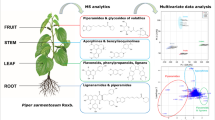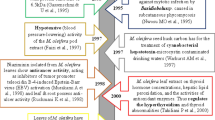Abstract
Lessertia frutescens L., commonly known as cancer-bush, is a medicinally reputed plant species indigenous to southern Africa. Field leaf extracts of this species are known to exhibit many curative properties. However, little is known about the bioactive compounds that are present in in vitro leaf extracts and seed extracts. The objective of this study was to verify the presence of and quantify l-canavanine, gamma amino butyric acid (GABA), arginine and d-pinitol in the seeds, field leaves and in vitro leaves of L. frutescens using gas and liquid chromatography. Methanolic extracts of in vitro leaves, field leaves and seeds were used. MRM chromatograms were recorded for l-canavanine and arginine using tandem mass spectrometry. GC chromatograms were recorded for GABA and d-pinitol using gas chromatography. d-Pinitol was found to be most abundant and was 14.75 and 18.17 mg/g in in vitro and field leaf extracts respectively, followed by GABA (7.29 and 3.48 mg/g), arginine (7.08 and 0.35 mg/g) and l-canavanine (0.55 and 0.08 mg/g). In the seed extracts, GABA content was found to be the highest (1.69 mg/g) followed by l-canavanine (0.37 mg/g), then d-pinitol (0.25 mg/g), and arginine (0.02 mg/g). In vitro leaves had higher quantities of all compounds, except for d-pinitol. This study therefore highlights the potential of bulking in vitro leaves for the extraction of the medicinal compounds, l-canavanine and GABA.



Similar content being viewed by others
References
Bell EA (2001) Ecological biochemistry and its development. Phytochemistry 56:223–227
Bourgaud F, Gravot A, Milesi S, Gontier E (2001) Production of plant secondary metabolites: a historical perspective. Plant Sci 161:839–851
Chadwick WA, Roux S, van de Venter M, Louw J, Oelofsen W (2007) Antidiabetic effects of Sutherlandia frutescens in Wistar rats fed a diabetogenic diet. J Ethnopharmacol 109:121–127
Cheng L, Xu Y, Grotewold E, Jin Z, Wu F, Fu C, Zhao D (2007) Characterization of anthocyanidin synthase (ANS) gene and anthocyanidin in rare medicinal plant-Saussurea medusa. Plant Cell Tissue Organ Cult 89:63–73
Colling J, Stander MA, Makunga NP (2010) Nitrogen supply and abiotic stress influence canavanine synthesis and the productivity of in vitro regenerated Sutherlandia frutescens microshoots. J Plant Physiol 167:1521–1524
Dias LLC, Santa-Catarina C, Ribeiro DM, Barros RS, Floh EIS, Otoni WC (2009) Ethylene and polyamine production patterns during in vitro shoot organogenesis of two passion fruit species as affected by polyamines and their inhibitor. Plant Cell Tissue Organ Cult 99:199–208
Ekanayake S, Skog K, Asp NG (2007) Canavanine content in sword beans (Canavalia gladiata): analysis and effect of processing. Food Chem Toxicol 45:797–803
Fait A, Fromm H, Walter D, Galili G, Fernie AR (2007) Highway or byway: the metabolic role of the GABA shunt in plants. Trends Plant Sci 13:14–19
Fu X, Li XC, Smillie TJ, Carvalho P, Mabusela W, Syce J, Johnson Q, Folk W, Avery MA, Khan IA (2008) Cycloartane glycosides from Sutherlandia frutescens. J Nat Prod 71:1749–1753
Ghias-Ud-Din M, Smith AE, Phillips DV (1981) Separation of pinitol and some other cyclitols by high-performance liquid chromatography. J Chromatogr 211:295–298
Gomes CI, Obendorf RL, Horbowicz M (2005) Myo-inositol, d-chiro-inositol, and d-pinitol synthesis, transport, and galactoside formation in soybean explants. Crop Sci 45:1312–1319
Hartmann T (2007) From waste products to ecochemicals: fifty years research of plant secondary metabolism. Phytochemistry 68:2831–2846
Hartnett SM, Oosthuizen V, van de Venter M (2005) Anti-HIV activities of organic and aqueous extracts of Sutherlandia frutescens and Lobostemon trigonus. J Ethnopharmacol 96:113–119
Horbowicz M, Obendorf RL (1994) Seed desiccation tolerance and storability: dependence on flatulence-producing oligosaccahrides and cyclitols—review and survey. Seed Sci Res 4:385–405
Hrabák A, Bajor T, Temesi A (1994) Comparison of substrate and inhibitor specificity of arginase and nitric oxide (NO) synthase for arginine analogues and related compounds in murine and rat macrophages. Biochem Biophys Res Commun 198:206–212
Jain R, Sinha A, Jain D, Kachhwaha S, Kothari, SL (2010) Adventitious shoot regeneration and in vitro biosynthesis of steroidal lactones in Withania coagulans (Stocks) Dunal. Plant Cell Tissue Organ Cult. doi:10.1007/s11240-010-9840-3
Kavanaugh D, Berge MA, Rosenthal GG (1990) A higher plant enzyme exhibiting broad acceptance of stereoisomers. Plant Physiol 94:67–70
Kuo TM, Lowell CA, Nelsen TC (1997) Occurrence of pinitol in developing soybean seed tissues. Phytochemistry 45:29–35
Kuo YH, Rozan P, Lambein F, Frias J, Vidal-Valverde C (2004) Effects of different germination conditions on the contents of free protein and non-protein amino acids of commercial legumes. Food Chem 86:537–545
Li X, Atkinson RN, King SB (2001) Preparation and evaluation of new l-canavanine derivatives as nitric oxide synthase inhibitors. Tetrahedron 57:6557–6565
McManus MT, Bieleski RL, Caradus JR, Barker DJ (2000) Pinitol accumulation in mature leaves of white clover in response to a water deficit. Environ Exp Bot 43:11–18
Moshe D (1998) A biosystematic study of the genus Sutherlandia R.Br. (Fabaceae, Galgeae). M.Sc. Thesis (Botany), University of Johannesburg
Mostafa SE, Karam NS, Shibi RA, Alali FQ (2010) Micropropagation and production of arbutin in oriental strawberry tree (Arbutus andrachne L.). Plant Cell Tissue Organ Cult 103:111–121
Murakeözy EP, Smirnoff N, Nagy Z, Tuba Z (2002) Seasonal accumulation pattern of pinitol and other carbohydrates in Limonium gmelini subsp. hungarica. J Plant Physiol 159:485–490
Natelson S, Bratton GR (1984) Canavanine assay of some alfalfa varieties (Medicago sativa) by fluorescence: practical procedure for canavanine preparation. Microchem J 29:26–43
Ojewole JAO (2008) Anticonvulsant property of Sutherlandia frutescens R.BR. (variety incana E.MEY.) [Fabaceae] shoot aqueous extract. Brain Res Bull 75:126–132
Pellati F, Benvenuti S (2008) Determination of ephedrine alkaloids in Ephedra natural products using HPLC on a pentafluorophenylpropyl stationary phase. Journal of Pharmaceut Biomed Anal 48:254–263
Phillipson JD (2007) Phytochemistry and pharmacognosy. Phytochemistry 68:2960–2972
Prevoo D, Swart P, Swart AC (2008) The influence of Sutherlandia frutescens on adrenal steroidogenic cytochrome P450 enzymes. J Ethnopharmacol 118:118–126
Rathore MS, Shekhawat NS (2009) Micropropagation of Pueraria tuberose (Roxb. Ex Willd.) and determination of puerarin content in different tissues. Plant Cell Tissue Organ Cult 99:327–334
Reid KA, Maes J, van Staden J, De Kimpe N, Mulholland DA, Verschaeve L (2006) Evaluation of the mutagenic and antimutagenic effects of South African plants. J Ethnopharmacol 106:44–50
Shaik S, Dewir YH, Singh N, Nicholas A (2010) Micropropagation and bioreactor studies of the medicinally important plant Lessertia (Sutherlandia) frutescens L. S Afr J Bot 76:180–186
Shelp BJ, Bown AW, McLean MD (1999) Metabolism and functions of gamma-aminobutyric acid. Trends Plant Sci 4:446–452
Shqueir AA, Brown DL, Klasing KC (1989) Canavanine content and toxicity of Sesbania leaf meal for growing chicks. Anim Feed Sci Technol 25:137–147
Sridhar KR, Seena S (2006) Nutritional and antinutritional significane of four unconventional legumes of the genus Canavalia—a comparative study. Food Chem 99:267–288
Stander BA, Marais S, Steynberg TJ, Theron D, Joubert F, Albrecht C, Joubert AM (2007) Influence of Sutherlandia frutescens extracts on cell numbers, morphology and gene expression in MCF-7 cells. J Ethnopharmacol 112:312–318
Swaffer DS, Ang CY, Desai PB, Rosenthal GA (1994) Inhibition of the growth of human pancreatic cancer cells by the arginine antimetabolite l-canavanine. Cancer Res 54:6045–6048
Tai J, Cheung S, Chan E, Hasman D (2004) In vitro culture studies of Sutherlandia frutescens on human tumor cell lines. J Ethnopharmacol 93:9–19
Udedibie ABI, Carlini CR (1998) Questions and answers to edibility problem of the Canavalia ensiformis seeds—a review. Anim Feed Sci Technol 74:95–106
van Wyk BE, Albrecht C (2008) A review of the taxonomy, ethnobotany, chemistry and pharmacology of Sutherlandia frutescens (Fabaceae). J Ethnopharmacol 119:620–629
Vermani K, Garg S (2002) Herbal medicines for sexually transmitted diseases and AIDS. J Ethnopharmacol 80:46–66
Wahid A, Gelani S, Ashraf M, Foolad MR (2007) Heat tolerance in plants: an overview. Environ Exp Bot 61:199–223
Wink M (2003) Evolution of secondary metabolites from an ecological and molecular phylogenetic perspective. Phytochemistry 64:3–19
Xaba PM, Notten A (2003) Sutherlandia frutescens. South African National Biodiversity Institute (SANBI). Available online http://www.plantzafrica.com/plantqrs/sutherfrut.htm. Accessed 12 Feb 2007
Yazaki K (2006) ABC transporters involved in the transport of plant secondary metabolites. FEBS Lett 580:1183–1191
Acknowledgments
Research funds were made available by the University of KwaZulu-Natal and the National Research Foundation.
Author information
Authors and Affiliations
Corresponding author
Rights and permissions
About this article
Cite this article
Shaik, S., Singh, N. & Nicholas, A. HPLC and GC analyses of in vitro-grown leaves of the cancer bush Lessertia (Sutherlandia) frutescens L. reveal higher yields of bioactive compounds. Plant Cell Tiss Organ Cult 105, 431–438 (2011). https://doi.org/10.1007/s11240-010-9884-4
Received:
Accepted:
Published:
Issue Date:
DOI: https://doi.org/10.1007/s11240-010-9884-4




